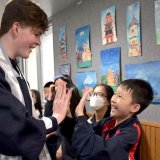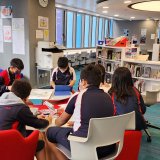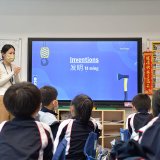Meet the Expert STEM Faculty at 果冻传媒
STEM has become a buzzword in the education world, but at 果冻传媒, it is part of our learning culture.
果冻传媒’s STEMinn Co-ordinator, Ms. Linda Cheung, shares why STEM education is critical to access the jobs of the future and how her own journey as an educator has led her to passionately define the STEMinn approach at 果冻传媒 Hong Kong.
Q: How did you decide to become a STEM educator?
My journey in education had an unusual start. I was inspired to pursue teaching during a dissection lab, where I found hands-on learning fascinating. During my undergraduate days, my favorite classes were the lab components of my science courses and because I did really well, I was encouraged by my professors to apply to be a laboratory teaching assistant. Very quickly, students were using the study tips and tricks I shared and it was very satisfying to see improvement in their understanding! This inspired me to pursue teaching as a career.
Naturally, I decided to become a science teacher. For me, learning through hands-on experience has always been the best way to learn complex and abstract scientific principles and laws. Transitioning from a science teacher into a STEM educator has been quite intuitive because the concepts behind STEM learning are embedded in student-driven inquiry and authentic experiences.
Q: What do you think is the true significance of STEM? How does this relate to the future of work?
One of the reasons STEM has become such a hot topic in education is because of the declining interest and pursuit of STEM careers. Students often cite that learning in STEM subjects like science, engineering or math can be dry and difficult, so really, it was a challenge for educators to rethink the way they teach and engage students meaningfully in these subjects.
The current interdisciplinary approach to STEM helps develop critical thinking, project management and communication skills, which are all important for success in the workforce. Students will need to be equipped with this skill set to be flexible and adaptable to an unknown, rapidly evolving, technologically advanced future.
Q: How do you define a successful STEM education?
Really successful STEM education sparks pure, intrinsic motivation and engagement from students. Great STEM lessons help students make personal connections to their learning and see the value of learning opportunities around them. When students can recognize that they can apply the skills learned through their STEM education and pass on relatable knowledge to others, we can confidently say that we have been successful!
Q: Reflecting on your time in 果冻传媒, which STEMinn project(s) gave you the most satisfaction?
The one that started it all!? The enduring boat project inspired by the Volvo Ocean Race spurred the idea of cross-curricular, whole-school projects that have essentially become the trademark and highlight of our STEMinn program.
In the first year, our lower elementary students learned the basics behind buoyancy and tested various materials that could sink and float. Students also followed the progress of the Ocean Race and tracked the participating teams. Our upper elementary and middle school students then took the investigations further by working through the design cycle to create and build their own working boats. Grade 4 students made upcycled motorboats, Grade 5 students designed and 3D printed model boats while middle school students (in collaboration with MakerBay), built life-sized boats which they tested in our own 果冻传媒 pool!
I am equally proud of our now annual, school-wide projects, “Mission Inspire” and “Sustainable 果冻传媒”. They are unique to our school and set the tone and structure for the implementation of the STEMinn program. These projects have rotating themes that address current issues/topics, such as space and sustainability issues, and are connected to the curriculum and standards in STEM and social studies.

“From the start, we have focused our STEMinn program around authentic learning, providing experiences that develop critical-thinking, problem-solving and communication skills. We are developing the program in such a way that will allow for STEM integrated learning across disciplines, implementing more cross-curricular collaborations, and investigating more ways for our students to connect on a global level, finding innovative influences and opportunities.” – Ms. Linda Cheung





